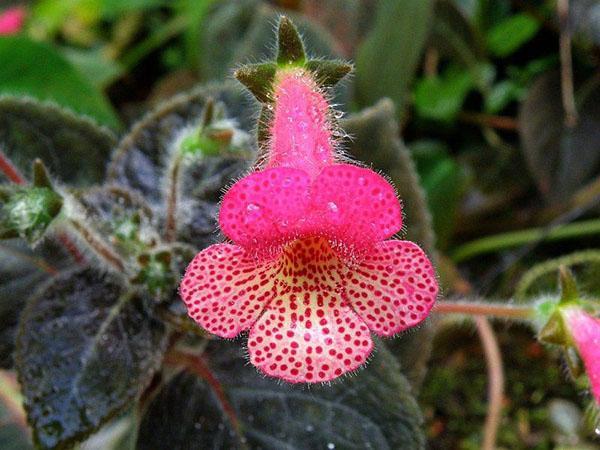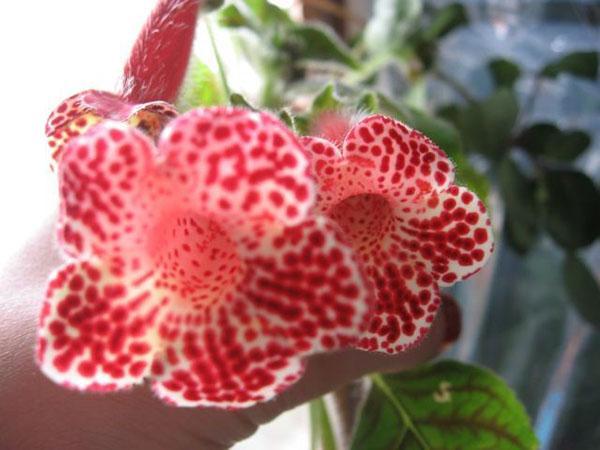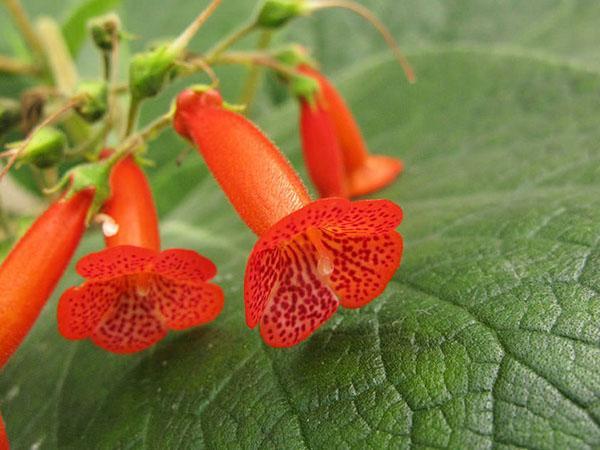Secrets of growing a decorative kaleria flower
 If you want to grow a spectacular, undemanding and rare plant, you should pay attention to the kaleria flower from the Gesneriev family. The plant blooms magnificently, and it is very easy to care for it. The most popular species that are grown at home are foxglove kaleria, pleasant kaleria, fluffy kaleria. Agrotechnical requirements for all species are practically the same. The plant is well suited for decorative floriculture.
If you want to grow a spectacular, undemanding and rare plant, you should pay attention to the kaleria flower from the Gesneriev family. The plant blooms magnificently, and it is very easy to care for it. The most popular species that are grown at home are foxglove kaleria, pleasant kaleria, fluffy kaleria. Agrotechnical requirements for all species are practically the same. The plant is well suited for decorative floriculture.
Description of kaleria flower

 The flowers resemble modified bells that have an elongated corolla. Their color can be different: from pink to dark brown, interspersed with a different shade. Most often, hybrids are grown at home that have a long flowering period.
The flowers resemble modified bells that have an elongated corolla. Their color can be different: from pink to dark brown, interspersed with a different shade. Most often, hybrids are grown at home that have a long flowering period.
Care features
This plant attracts and surprises with its beautiful flowers. Kaleria, such as in the photo, does not need special care at home. It grows well in warmth, in the absence of drafts. It is only important to provide her with systematic watering.
Temperature and lighting
 In spring and summer, the most suitable temperature for intense flowering and good flower condition is 20 - 25 ° C. After the plant passes into a dormant period, the temperature must be reduced. The optimum temperature will be 16 -17 ° C. It is important to consider that the plant does not tolerate drafts.
In spring and summer, the most suitable temperature for intense flowering and good flower condition is 20 - 25 ° C. After the plant passes into a dormant period, the temperature must be reduced. The optimum temperature will be 16 -17 ° C. It is important to consider that the plant does not tolerate drafts.
For well-being, kaleria flowers need diffused lighting and no direct sunlight. At the same time, the leaves of the plant become bright and thick. The optimal location is windows with east and west orientation. If the windows have a south orientation, the kaleria is slightly moved away from the light so that its leaves do not turn yellow. Placing a plant on north-facing windows may not have enough lighting.
In winter, the kaleria flower also needs to be provided with the required amount of light..
Watering and moisture
 The flower should be watered moderately during active growth. From spring, after its awakening, and until autumn, while it blooms. It is imperative to monitor the soil. In the heat, home care for kaleria consists in frequent watering to prevent the land from drying out. In winter, they rarely watered, as the soil dries out.
The flower should be watered moderately during active growth. From spring, after its awakening, and until autumn, while it blooms. It is imperative to monitor the soil. In the heat, home care for kaleria consists in frequent watering to prevent the land from drying out. In winter, they rarely watered, as the soil dries out.
If the aerial part of the kaleria has died out, watering is still continued, because in its absence, the root will completely dry out.
The plant prefers high humidity. When the air is very dry, for example, in winter during the heating season, the pot of calories must be placed on a pallet with expanded clay and water. But so that the pot does not touch the water.
To create a humid environment, you can spray the air with water at room temperature. Do not spray the flower itself, because its leaves are pubescent. It must be remembered that if water gets on the leaves of the plant, dark spots may appear on them.
Transplant and substrate
 If necessary, the kaleria can be transplanted in the spring. Experienced flower growers advise not to separate the soil from the roots, but simply transfer the flower into a new wide and shallow flowerpot. The growing substrate is created from sod, leafy soil, peat and sand in this ratio of 1: 2: 1: 1. It is useful to supplement the soil with charcoal, which absorbs excess moisture, which has a detrimental effect on the root system.
If necessary, the kaleria can be transplanted in the spring. Experienced flower growers advise not to separate the soil from the roots, but simply transfer the flower into a new wide and shallow flowerpot. The growing substrate is created from sod, leafy soil, peat and sand in this ratio of 1: 2: 1: 1. It is useful to supplement the soil with charcoal, which absorbs excess moisture, which has a detrimental effect on the root system.
The choice of the pot directly depends on the size of the rhizome of the kaleria flower. The most suitable option is not a deep, but spacious flowerpot with a diameter of 15 cm. It can be ceramic or plastic. It is preferable to use a ceramic pot because it retains moisture longer and the roots do not overheat. In addition, when placing flowers on a window, a ceramic pot will add stability to them.
In order for a flower to grow and bloom well, it needs to be fertilized. To do this, complex fertilizers are applied to the soil 1-2 times a month, which are suitable for flowering plants.
The period of intense flowering of kaleria falls in summer-autumn. During dormancy, the vital activity of the plant does not stop, therefore, caring for a flower with kaleria at home consists in periodic watering.
Reproduction methods
 The undemandingness of kaleria also lies in the fact that three options for its reproduction are available at home. Which is quite rare in exotic tropical plants.
The undemandingness of kaleria also lies in the fact that three options for its reproduction are available at home. Which is quite rare in exotic tropical plants.
Kaleria can be propagated in the following ways:
- seeds;
- cuttings;
- dividing the rhizome.
Seed propagation
 The seeds should be sown in a substrate of leafy soil and sand. It is not necessary to sprinkle them with earth, but only gently spray with water, then cover with polyethylene. Place containers with kaleria seeds in a warm place. The optimum temperature for germination is 23 ° C.
The seeds should be sown in a substrate of leafy soil and sand. It is not necessary to sprinkle them with earth, but only gently spray with water, then cover with polyethylene. Place containers with kaleria seeds in a warm place. The optimum temperature for germination is 23 ° C.
When the seedlings sprout, they must be planted at a distance of 2 cm into the soil of the same composition. The ground should be regularly sprayed with a spray bottle. After 1.5 months, the grown plants must be planted again at a distance of 3 cm.
Seedlings can be planted in personal pots when they grow and get stronger. Each kaleria flower needs a pot with a diameter of 7 cm.The substrate for seedlings consists of the following elements:
- sod land - 1/2 part;
- leaf land - 2 parts;
- sand - 1 part;
- peat soil - 1 part.
Before the bush forms, the top of the seedlings is pinched to stimulate the development of lateral shoots.
Cuttings
 To propagate kaleria by cuttings, it is necessary to cut off the top of the shoot and plant it in a container with leafy soil and sand. Moisten the substrate and cover with plastic wrap. The soil needs to be aired and watered daily.
To propagate kaleria by cuttings, it is necessary to cut off the top of the shoot and plant it in a container with leafy soil and sand. Moisten the substrate and cover with plastic wrap. The soil needs to be aired and watered daily.
Kaleria should take root within 2 weeks. When the young shoot begins to grow, it must be transplanted into an individual pot.
To stimulate root formation, cuttings can be placed in a stimulant solution for 2-3 hours before planting.
Leaves can be used instead of shoots. They must be placed in water or planted in wet sand. But their roots form more slowly, over several months.
Root division
 At home, the easiest way to breed kaleria is by dividing the root. To do this, in the spring, during a flower transplant, you need to divide the tuberous roots with a sharp knife. Sprinkle the cut with charcoal and leave to dry slightly. Then plant them in individual flowerpots. The roots must be deepened a few centimeters into the soil and watered. After a while, a new plant should grow from each part of the root.
At home, the easiest way to breed kaleria is by dividing the root. To do this, in the spring, during a flower transplant, you need to divide the tuberous roots with a sharp knife. Sprinkle the cut with charcoal and leave to dry slightly. Then plant them in individual flowerpots. The roots must be deepened a few centimeters into the soil and watered. After a while, a new plant should grow from each part of the root.
Even a beginner in floriculture can grow an exquisite, unusual, easy to care for and reproduce red calale. If you follow all the rules, she will delight others for a long time with her beautiful and bright flowers.
Hello. Help me please. At the kaleria flower, the leaves turn black with black dots.The flower seller said to wipe the back of the leaf with alcohol. Proejerlo and two leaves dried up at once. Transplanted into another pot, and black dots are spreading all over. I do not know what to do! Why does this happen, or is it hot in our house and we turned on the air conditioner? ..
The plant must be treated with a fungicide. Read the article carefully and try to comply with all the conditions for keeping the flower. The plant can be infected or so react to improper care.
I have calorie trunks being sent all the time. Everything seems to be going fine, but suddenly, in the root area and above, the stem begins to dry out. The top is green and so may time
Add a photo, please.